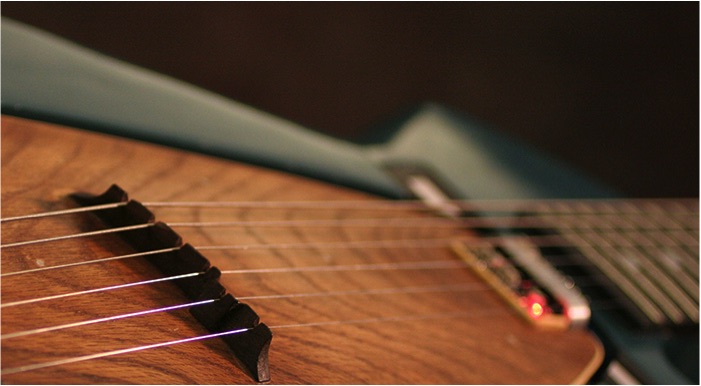


The Chameleon Guitar: Guitar With a Replaceable Resonator
2009
Credits: Amit Zoran, Pattie Maes, Joe Paradiso, Stephen Welch and William D. Hunt
Each acoustic instrument is one of a kind. Its unique acoustic properties are transferred from the physical characteristics of its source materials and a handcrafted touch. In contrast, electronic and computer-based instruments lack this distinguishing trait. Though the technology support in musical instruments offers great flexibility, it tends to foster predictable and generic results, particularly with common use of easily-cloned digital presets.
The Chameleon Guitar presents a new approach to the design and fabrication of instruments that combine the advantage of acoustic and electric instruments—hybrid instruments—that exist simultaneously in both physical and digital environments. This approach exploits physical/acoustic properties via a replaceable physical object complemented by a simulated shape or other digital signal manipulation. This work aims to demonstrate the possibility of maintaining the qualities found in real acoustic instruments, such as unique spectral and spatial behavior of wooden soundboards, with the flexibility of digital processing.
Go HERE for sound examples.
Publication:
Zoran, Amit Stephen Welch and William D. Hunt. 2012. “A Platform for Manipulation and Examination of the Acoustic Guitar: The Chameleon Guitar.” Applied Acoustics, volume 73, issue 4, April 2012, pages 338-347. PDF
Zoran, Amit and Joseph A. Paradiso. 2011. “The Chameleon Guitar—Guitar with a Replaceable Resonator.”Journal of New Music Research (JNMR), volume 40, issue 1, March 2011, pages 59-74. PDF
Zoran, Amit, Marco Coppiardi, Paula Aguilera and Pattie Maes. 2009. “Physical Heart in a Virtual Body.” In Proceedings of the 27th international conference extended abstracts on Human factors in computing systems (CHI '09). ACM, New York, NY, USA.
CAD File (Rhino):
Top left: the Chameleon Guitar and resonator: (A) a cedar resonator with an arch-top guitar bridge inside the guitar; (B) the rear of the Chameleon Guitar – the resonator tray open, and the DSP unit; (C) the rear of a spruce resonator with koa support and sensors. Right: eight resonators. The first four are more traditional, made from wood only. The last five are more experimental, including loose screws, springs, free plates or plastic chamber with rice or water. Resonator no. 1 was used as the reference for algorithm development.
-------------------------------------------------------------------------------------------------------------------------------------------------------------------------
Bottom left: eigenmode shapes (<1000 Hz) for resonators of different woods with no sensors and wax finish, and for cedar resonator with and without sensors and wax finish, determined with laser doppler vibrometry. Used to evaluate the ability to generalize conclusions regarding sensor locations from spruce to other woods, and to evaluate how the positioning of the sensors influences the behavior of the resonator. Four main shapes were determined as repetitive modes, appearing in most of the tests and grouped into different colors. For each mode, gray areas indicate moving parts.
Amit S Zoran
zoran at cs dot huji dot ac dot il
Room A116, Rothberg Family Buildings, The Edmond J. Safra Campus
91904 Jerusalem, Israel